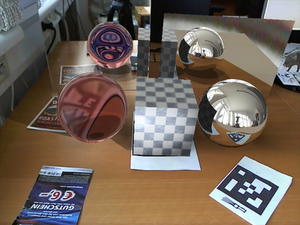Information
- Publication Type: Bachelor Thesis
- Workgroup(s)/Project(s):
- Date: November 2012
- Date (Start): 1. March 2012
- Date (End): 30. November 2012
- Matrikelnummer: 0926881
- First Supervisor:
- Keywords: Refraction, OptiX, Augmented Reality, Reflection
Abstract
In mixed reality, virtual objects are inserted into a video stream of a real environment. This technique can be used for many applications including marketing, simulations and cultural heritage. Therefore it is important that the images look plausible. Many applications also have real time constraints. With traditional rasterization it is difficult to create realistic reflections and refractions. In ray tracing on the other hand this is a trivial task, but rendering is slow. The solution described in this work uses the graphics card for speeding up ray tracing. Additionally it employs a rasterizer for diffuse surfaces and only traces rays if there is a reflective or refractive surface visible. This works by creating a ray tracing mask using the fast rasterizer in a first step. It holds true for reflective or refractive surfaces and false otherwise. Then all diffuse objects are drawn using the rasterizer. Finally rays are traced on each pixel which is masked as reflective or refractive surface by the ray tracing mask. These rays produce secondary rays which can hit a diffuse surface eventually. In this case the ray tracer takes over the shading. Results show, that our hybrid rendering method allows high quality reflections and refractions while still having interactive frame rates in mixed reality scenarios.Additional Files and Images
Weblinks
No further information available.BibTeX
@bachelorsthesis{celarek_adam-2012-rrmro,
title = "Merging Ray Tracing and Rasterization in Mixed Reality",
author = "Adam Celarek",
year = "2012",
abstract = "In mixed reality, virtual objects are inserted into a video
stream of a real environment. This technique can be used for
many applications including marketing, simulations and
cultural heritage. Therefore it is important that the images
look plausible. Many applications also have real time
constraints. With traditional rasterization it is difficult
to create realistic reflections and refractions. In ray
tracing on the other hand this is a trivial task, but
rendering is slow. The solution described in this work uses
the graphics card for speeding up ray tracing. Additionally
it employs a rasterizer for diffuse surfaces and only traces
rays if there is a reflective or refractive surface visible.
This works by creating a ray tracing mask using the fast
rasterizer in a first step. It holds true for reflective or
refractive surfaces and false otherwise. Then all diffuse
objects are drawn using the rasterizer. Finally rays are
traced on each pixel which is masked as reflective or
refractive surface by the ray tracing mask. These rays
produce secondary rays which can hit a diffuse surface
eventually. In this case the ray tracer takes over the
shading. Results show, that our hybrid rendering method
allows high quality reflections and refractions while still
having interactive frame rates in mixed reality scenarios.",
month = nov,
address = "Favoritenstrasse 9-11/E193-02, A-1040 Vienna, Austria",
school = "Institute of Computer Graphics and Algorithms, Vienna
University of Technology ",
keywords = "Refraction, OptiX, Augmented Reality, Reflection",
URL = "https://www.cg.tuwien.ac.at/research/publications/2012/celarek_adam-2012-rrmro/",
}


 paper
paper
